Subscribe to our ▶️ YouTube channel 🔴 for the latest videos, updates, and tips.
Problems on Parallelogram
These are the various types of solved problems on parallelogram.
1. Prove that any two adjacent angles of a parallelogram are supplementary.
Solution:
Let ABCD be a parallelogram
Then, AD ∥ BC and AB is a transversal.
Therefore, A + B = 180° [Since, sum of the interior angles on the same side of the transversal is 180°]
Similarly, ∠B + ∠C = 180°, ∠C + ∠D = 180° and ∠D + ∠A = 180°.
Thus, the sum of any two adjacent angles of a parallelogram is 180°.
Hence, any two adjacent angles of a parallelogram are supplementary.
2. Two adjacent angles of a parallelogram are as 2 : 3. Find the measure of each of its angles.
Solution:
Let ABCD be a given parallelogram
Then, ∠A and ∠B are its adjacent angles.
Let ∠A = (2x)° and ∠B = (3x)°.
Then, ∠A + ∠B = 180° [Since, sum of adjacent angles of a ∥gm is 180°]
⇒ 2x + 3x = 180
⇒ 5x = 180
⇒ x = 36.
Therefore, ∠A = (2 × 36)° = 72° and ∠B = (3 × 36°) = 108°.
Also, ∠B + ∠C = 180° [Since, ∠B and ∠C are adjacent angles]
= 108° + ∠C = 180° [Since, ∠B = 108°]
∠C = (180° - 108°) = 72°.
Also, ∠C + ∠D = 180° [Since, ∠C and ∠D are adjacent angles]
⇒ 72° + ∠D = 180°
⇒ ∠D = (180° - 72°) 108°.
Therefore, ∠A = 72°, ∠B = 108°, ∠C = 72°and ∠D = 108°.
3. In the adjoining figure, ABCD is a parallelogram in which ∠A = 75°. Find the measure of each of the angles ∠B, ∠C and ∠D.
Solution:
It is given that ABCD is a parallelogram in which ∠A = 75°.
Since the sum of any two adjacent angles of a parallelogram is 180°,
∠A + ∠B = 180°
⇒ 75° + ∠B = 180°
⇒∠B = (180° - 75°) = 105°
Also, ∠B + ∠C = 180° [Since, ∠B and ∠C are adjacent angles]
⇒ 105° + ∠C = 180°
⇒ ∠C = (180° - 105°) = 75°.
Further, ∠C + ∠D = 180° [Since, ∠C and ∠D are adjacent angles]
⇒ 75° + ∠D = 180°
⇒ ∠D = (180° - 75°) = 105°.
Therefore, ∠B = 105°, ∠C = 75° and ∠D = 105°.
4. In the adjoining figure, ABCD is a parallelogram in which
∠BAD = 75° and ∠DBC = 60°. Calculate:
(i) ∠CDB and (ii) ∠ADB.
Solution:
We know that the opposite angles of a parallelogram are equal.
Therefore, ∠BCD = ∠BAD = 75°.
(i) Now, in ∆ BCD, we have
∠CDB + ∠DBC + ∠BCD = 180°
[Since, sum of the angles of a triangle is 180°]
⇒ ∠CDB + 60° + 75° = 180°
⇒ ∠CDB + 135° = 180°
⇒ ∠CDB = (180° - 135°) = 45°.
(ii) AD ∥ BC and BD is the transversal.
Therefore, ∠ADB = ∠DBC = 60° [alternate interior angles]
Hence, ∠ADB = 60°.
5. In the adjoining figure, ABCD is a parallelogram in which
∠CAD = 40°, ∠BAC = 35° and ∠COD = 65°.
Calculate: (i) ∠ABD (ii) ∠BDC (iii) ∠ACB (iv) ∠CBD.
Solution:
(i) ∠AOB = ∠COD = 65° (vertically opposite angles)
Now, in ∆OAB, we have:
∠OAB + ∠ABO + ∠AOB =180° [Since, sum of the angles of a triangle is 180°]
⇒ 35°+ ∠ABO + 65° = 180°
⇒ ∠ABO + 100° = 180°
⇒ ∠ABO = (180° - 100°) = 80°
⇒ ∠ABD = ∠ABO = 80°.
(ii) AB ∥ DC and BD is a transversal.
Therefore, ∠BDC = ∠ABD = 80° [alternate interior angles]
Hence, ∠BDC = 80°.
(iii) AD ∥ BC and AC is a transversal.
Therefore, ∠ACB = ∠CAD = 40° [alternate interior angles]
Hence, ∠ACB = 40°.
(iv) ∠BCD = ∠BAD = (35° + 40°) = 75° [opposite angles of a parallelogram]
Now, in ∆CBD, we have
∠BDC + ∠BCD + ∠CBD = 180° [sum of the angles of a triangle is 180°]
⇒ 80° + 75° + ∠CBD = 180°
⇒ 155° + ∠CBD = 180°
⇒ ∠CBD = (180° - 155°) = 25°.
Hence, ∠CBD = 25°.
6. In the adjoining figure, ABCD is a parallelogram, AO and BO are the bisectors of ∠A and ∠B respectively. Prove that ∠AOB = 90°.
Solution:
We know that the sum of two adjacent angles of a parallelogram is 180°
Therefore, ∠A + ∠B = 180° ……………. (i)
Since AO and BO are the bisectors of ∠A and ∠B, respectively, we have
∠OAB = 1/2∠A and ∠ABO = 1/2∠B.
From ∆OAB, we have
∠OAB + ∠AOB + ∠ABO = 180° [Since, sum of the angles of a triangle is 180°]
⇒ ¹/₂∠A + ∠ABO + ¹/₂∠B = 180°
⇒ ¹/₂(∠A + ∠B) + ∠AOB = 180°
⇒ (¹/₂ × 180°) + ∠AOB = 180° [using (i)]
⇒ 90° + ∠AOB = 180°
⇒ ∠AOB = (180° - 90°) = 90°.
Hence, ∠AOB = 90°.
7. The ratio of two sides of a parallelogram is 4 : 3. If its perimeter is 56 cm, find the
lengths of its sides.
Solution:
Let the lengths of two sides of the parallelogram be 4x cm and 3x cm respectively.
Then, its perimeter = 2(4x + 3x) cm = 8x + 6x = 14x cm.
Therefore, 14x = 56 ⇔ x = ⁵⁶/₁₄ = 4.
Therefore, one side = (4 × 4) cm = 16 cm and other side = (3 × 4) cm = 12 cm.
8. The length of a rectangle is 8 cm and each of its diagonals measures 10 cm. Find
its breadth.
Solution:
Let ABCD be the given rectangle in which length AB = 8 cm and diagonal AC = 10 cm.
Since each angle of a rectangle is a right angle, we have
∠ABC = 90°.
From right ∆ABC, we have
AB² + BC² = AC² [Pythagoras’ Theorem]
⇒ BC² = (AC² - AB²) = {(1O)² - (8)²} = (100 - 64) = 36
⇒ BC = √36 = 6cm.
Hence, breadth = 6 cm.
9. In the adjacent figure, ABCD is a rhombus whose diagonals AC and BD intersect at a point O. If side AB = 10cm and diagonal BD = 16 cm, find the length of diagonal AC.
Solution:
We know that the diagonals of a rhombus bisect each other at right angles
Therefore, BO = ¹/₂BD = (¹/₂ × 16) cm = 8 cm, AB = 10 cm and ∠AOB = 90°.
From right ∆OAB, we have
AB² = AO² + BO²
⇒ AO² = (AB² – BO²) = {(10) ² - (8)²} cm²
= (100 - 64) cm²
= 36 cm²
⇒ AO = √36 cm = 6 cm.
Therefore, AC = 2 × AO = (2 × 6) cm = 12 cm.
Parallelogram
Properties of a Rectangle Rhombus and Square
Practice Test on Parallelogram
Parallelogram - Worksheet
8th Grade Math Practice
From Problems on Parallelogram to HOME PAGE
Didn't find what you were looking for? Or want to know more information about Math Only Math. Use this Google Search to find what you need.
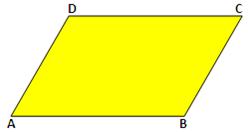
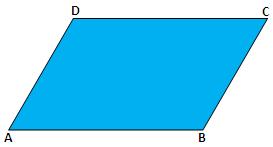
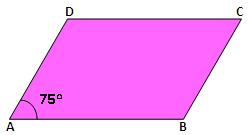
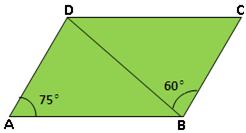
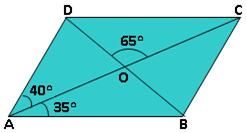
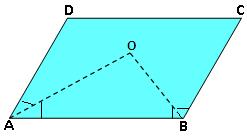
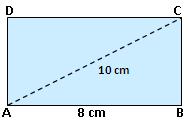



New! Comments
Have your say about what you just read! Leave me a comment in the box below. Ask a Question or Answer a Question.